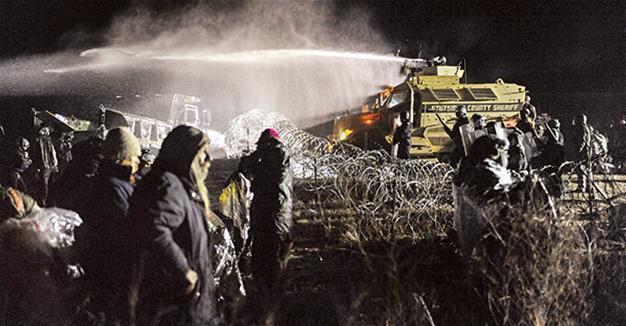Police, protesters face off at Dakota Access pipeline
CANNON BALL, North Dakota

REUTERS photo
Tension flared anew on the Dakota Access pipeline as protesters tried to push past a long-blocked bridge on a state highway, only to be turned back by a line of law enforcement using water cannon and what appeared to be tear gas, The Associated Press reported.The Nov. 20 skirmishes began around 6 p.m. after protesters removed a burned-out truck on what’s known as the Backwater Bridge, not far from the encampment where they have been for weeks as they demonstrate against the pipeline. The Morton County Sheriff’s Department estimated 400 protesters sought to cross the bridge on state Highway 1806.
A live stream seen by The Associated Press early Nov. 21 showed a continued standoff, with large lights illuminating smoke wafting across the scene.
At least one person was arrested. Protesters said a gym in Cannon Ball was opened to aid demonstrators who were soaked on a night the temperature dipped into the low 20s or were hit with tear gas.
Rema Loeb told The Associated Press he was forced to retreat from the bridge because he feared being doused with water on the freezing night. Others, he said, needed medical treatment after being hit with tear gas.
“It’s been just horrible,” said the 83-year-old Loeb, who traveled from Massachusetts about two weeks ago to join the protests.
The 1,200-mile, four-state pipeline is being built to carry oil from western North Dakota to a shipping point in Illinois. But construction of the $3.8 billion pipeline has been protested for months by the Standing Rock Sioux, whose reservation lies near the pipeline route, and the tribe’s allies, who fear a leak could contaminate their drinking water. They also worry that construction could threaten sacred sites.
Energy Transfer Partners has said no sites have been disturbed and that the pipeline will have safeguards against leaks, and is a safer method of transport for oil than rail or truck. The company has said the pipeline is largely complete except for the section under Lake Oahe.
The bridge lies near where protesters had set up camp on private property owned by the pipeline developer, Energy Transfer Partners, before they were forcibly removed by law enforcement Oct. 27. It’s also about a mile from an uncompleted section under Lake Oahe, a Missouri River reservoir, where work has been on hold by order of federal agencies.
















